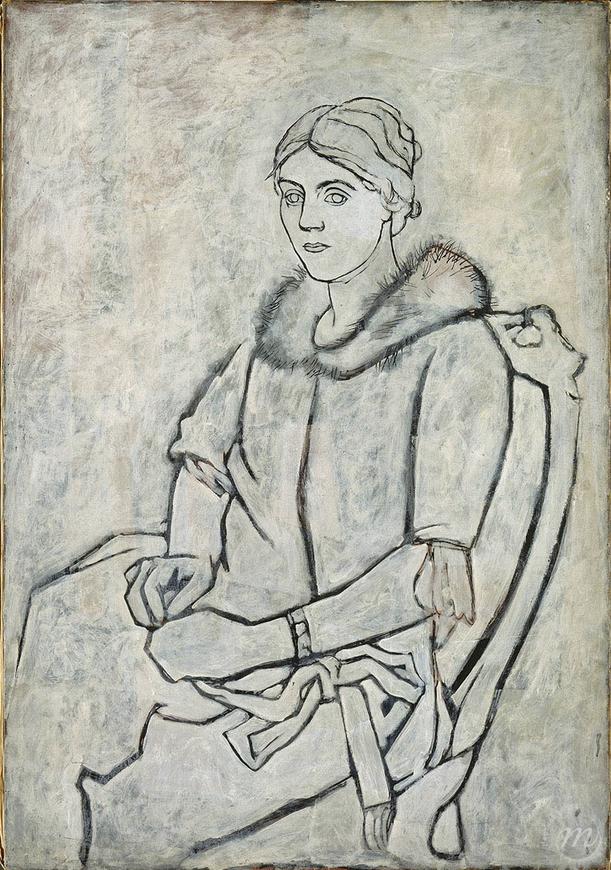In numerous portraits of Olga, Picasso took inspiration from depictions of women by Jean-Auguste-Dominique Ingres, and from one painting in particular: Portrait of Mademoiselle Caroline Rivière. There is the same purity of face, the same hairstyle, the same time-honoured pose – turned slightly to the side – and the same use of fur and finery, but a different and very personal graphic and pictorial rendering. Here the face is reminiscent of classical statuary, the shapes are stylised and simplified, the pupil-less eyes betray no emotion: Olga seems to have been turned to stone!
This lack of emotion is evidence of Picasso's sentimental remoteness during this period; he tired of his first wife and their society lifestyle, and portrayed Olga as dehumanised, robbed of her sparkle of old. This impression is accentuated by the stark composition, lacking any scenery or perspective, and the monochrome palette, all of which create a strange, almost unsettling atmosphere, an impression reinforced by the deliberate distortion of Olga's hands. The perfect mastery of line, which simultaneously contrasts with and complements the thick brushwork, demonstrates Picasso's artistic virtuosity.
An x-ray of a painting can reveal plenty of interesting things, including how canvases are recycled! Beneath this white monochrome painting there is a very complete cubist composition featuring a rather different portrait of a seated woman.
Long-term loan from the Musée Picasso, Paris.
D 990.1.1 (P 2004)

In numerous portraits of Olga, Picasso took inspiration from depictions of women by Jean-Auguste-Dominique Ingres, and from one painting in particular: Portrait of Mademoiselle Caroline Rivière. There is the same purity of face, the same hairstyle, the same time-honoured pose – turned slightly to the side – and the same use of fur and finery, but a different and very personal graphic and pictorial rendering. Here the face is reminiscent of classical statuary, the shapes are stylised and simplified, the pupil-less eyes betray no emotion: Olga seems to have been turned to stone!
This lack of emotion is evidence of Picasso's sentimental remoteness during this period; he tired of his first wife and their society lifestyle, and portrayed Olga as dehumanised, robbed of her sparkle of old. This impression is accentuated by the stark composition, lacking any scenery or perspective, and the monochrome palette, all of which create a strange, almost unsettling atmosphere, an impression reinforced by the deliberate distortion of Olga's hands. The perfect mastery of line, which simultaneously contrasts with and complements the thick brushwork, demonstrates Picasso's artistic virtuosity.
An x-ray of a painting can reveal plenty of interesting things, including how canvases are recycled! Beneath this white monochrome painting there is a very complete cubist composition featuring a rather different portrait of a seated woman.
Long-term loan from the Musée Picasso, Paris.
D 990.1.1 (P 2004)